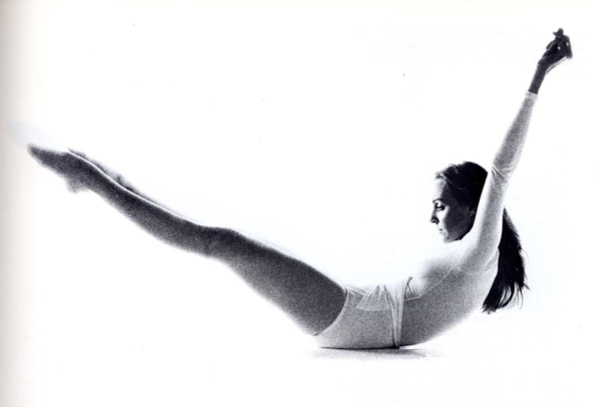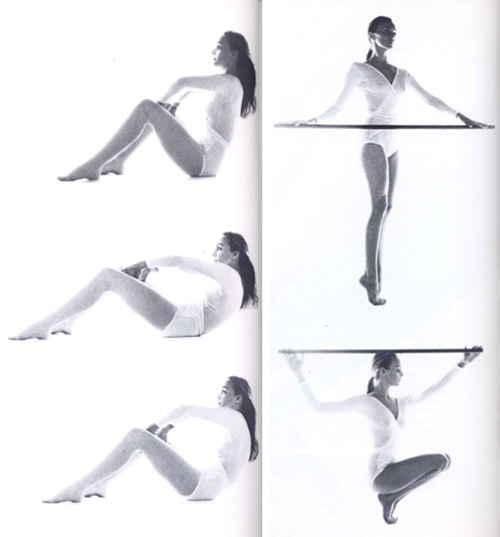Just off a fresh Pure Barre (PB) class.

I loved it because it was very fast paced, while still utilizing a logical sequence of exercises. floor work . As in all “barre-type” classes, we started standing, using small arm weights, and then progressed to leg work: thigh and hip, and then abdominal work. We went to the floor for a few more exercise of each of the above, and then stretch. For more specifics see: videos on pure barre technique
The resistance gear is the same small non-weighted medicine ball, placed between the thighs and/or ankles for inner thigh work. PB has different resistance bands, consisting of two circle loops that are put on the foot while the leg is extended back.

The next day I feel soreness in the small muscles inside the hip joint, proving I got the exercise right enough to be sore. That’s the PB challenge: to get the form right, to insure you are working the correct muscles each time. This takes more than one class, or even two, so be prepared to feel a lot more comfortable in the exercises after or around the third time.
I think the abs work is good, although it’s not as killer as a mat reformer class. PB is not a huge proponent of the dreaded “c curve.” IE has always found it distracting how difficult it is to maintain the position, and once the form is lost the exercise is not as effective. Some of us, like IE, are strong in our upper bodies with heavy musculature, which puts more strain on the neck and makes it more difficult to contact the lower abs.

So PB tackles the abs in several ways: first we are allowed to use the ball in the small of the back, relieving pressure from the low-neck and allowing better engagement of lower abs. We also did legs up in air and crossing ankles fast with a slight lift of the tail, while still keeping seat on the floor. We also worked the oblique muscles in a lying down position with head on the floor and crunching to the side while lifting.
PB has a boot-camp-quality as the exercises are pared down consisting of shorter sets with small modifications every 10 sets. You’re still shaking with the thigh work, with your back against the wall and legs stretching up to the bar. You're sweating. It's intense.

Owner Meg agrees saying it’s PB's “fast pace” that sets it apart from other bar-method-type classes. “You came here to finish” was what Meg said told us often through the class. “Find the connection of your mind into your abs.. make your body do what you want.” It’s a nice thought that even works sometimes!

Bar Method Marin

Some
things have changed: most notably the "c curve" – the used-to-be-holy
grail of bar method.

It has morphed into doing a lifted c curve with mats behind the back and then also to seated lifts.
I am reminded of Graham floor work which Lydia Bach, as seen here in these lovely soft focus seventies shots, was heavily influenced by. She became Lotte Berk's teacher who then founded the Bar Method.
 lotte berk book with lovely pictures of lydia bach
lotte berk book with lovely pictures of lydia bach
It is more graceful than PB. Bar Method gives more reps of the same exercise, as Bar Method Marin owner and instructor Cyndi says, "It's there to give you time to realize, ah ha that’s how I do this.”

It has morphed into doing a lifted c curve with mats behind the back and then also to seated lifts.
I am reminded of Graham floor work which Lydia Bach, as seen here in these lovely soft focus seventies shots, was heavily influenced by. She became Lotte Berk's teacher who then founded the Bar Method.
 lotte berk book with lovely pictures of lydia bach
lotte berk book with lovely pictures of lydia bachIt is more graceful than PB. Bar Method gives more reps of the same exercise, as Bar Method Marin owner and instructor Cyndi says, "It's there to give you time to realize, ah ha that’s how I do this.”
IE felt the positions in Bar Method were more dancerly.

They seemed to be teaching the exerciser how to be more graceful, and to bring that awareness into everyday life. It's the type of workout that shapes your body and mind at the same time. Happily, it's an exercise you can keep coming back to through body and life changes.

They seemed to be teaching the exerciser how to be more graceful, and to bring that awareness into everyday life. It's the type of workout that shapes your body and mind at the same time. Happily, it's an exercise you can keep coming back to through body and life changes.
Dailey Method class remains much as I remembered it.

There seems to be more standing work with arms, and even on the floor, more pushups and plank positions thrown in. Like other barre method classes the dreaded “c curve” has been altered with more abdominal exercise done sitting up on floor, and more tucking of the pelvis in lots of positions.
Dailey method seems to have the most tucks of any
of these classes. One nifty exercise was water skiing in a dancer fourth
position with the hip of the leg behind tucking and lifting up. Another way to
get at the pretzel type seat work.


The instructor tells us exactly what muscle group we are
working on, “try to use the lower side where the thigh comes into the leg and
up underneath it into the back” I can see the other women’s faces as they find
that place, and lift from there. One lady struggled, smiling, through a lot of
the exercises, not because she wasn’t strong enough to do them, but because her
body wasn’t used to doing these particular moves.
I heard her say to her friend that even though she didn’t get it all, “I bought
the 10 pack so I’ll be back.”
Like many other ladies
she came with friend, and saw a few other friends. The camaraderie of the
class environment was a draw as well.
Reformer classes.
Pilates, let’s face it, can be a little dry. It’s so
serious, all those micro movements done with so much control.
That’s where reformer classes come in.
 It’s the
camaraderie of a class, combined with almost personalized instruction that makes these classes a hit. Classes usually have 6- 8 students, so the teacher can check form frequently. The class format also lets you practice in an environment that's not so clinical and focused.
It’s livelier, and faster, as you watch other students, and the
carriages are clanking back and forth and the springs clicking off and on. You also lose the pressure to
be right, right way.
It’s the
camaraderie of a class, combined with almost personalized instruction that makes these classes a hit. Classes usually have 6- 8 students, so the teacher can check form frequently. The class format also lets you practice in an environment that's not so clinical and focused.
It’s livelier, and faster, as you watch other students, and the
carriages are clanking back and forth and the springs clicking off and on. You also lose the pressure to
be right, right way.So, all in all what did IE think of all this "barring?" I think it's a very valuable tool to re-educate and enliven the body as it changes and ages. I remember all my years of dancing and Martha Graham’s saying, “this is a dancers life.”

I think a dancer's life is like any life, in that we are always looking for ways to be comfortable and healthy in our bodies. As a dancer that means one thing, but over time it becomes something else. That something else is this connection, this conversation with the body. That’s what is so appealing about these types of classes that aren’t only killer cardio, tricky dance choreography, or stretch yoga sequences. (but actually combine elements of all of these.)
It's about developing a different type of communication, learning to talk to your body and then to listen. The environment is simple and pared down, and a quiet revelation can come upon you when you stop thinking, and feel your body knowing what to do.

I think of the Elle article where Dr Seger says, “We’re cultivating your lifelong relationship with movement. Only you can decide what that looks like day to day,”
That’s what Plie Releve Life is all about: IE and ID getting out there
and telling you what’s happening in the world of dance, exercise, and movement.IE wants to inspire you along with herself to do your reps, feel your body, and realize there is something
there that’s a lot more than lists and to-do's. That’s what we should be going for. That’s
the “relationship with your body, " and more importantly with movement that our Dr Seger is talking
about.

No comments:
Post a Comment
we love comments--leave them here--with your name (no url needed)